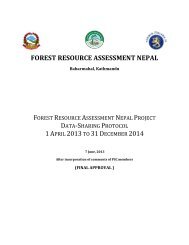Download - FRA Nepal
Download - FRA Nepal
Download - FRA Nepal
Create successful ePaper yourself
Turn your PDF publications into a flip-book with our unique Google optimized e-Paper software.
To meet the stipulated objectives, six primary and six supportive programs were developed. It is important to note that forest<br />
resource information and management planning is one of the supportive programs of the MFPS (1989). The program aims to<br />
generate, update and use forest statistics and information for decision support system.<br />
1.4.1.2 Revised Forestry Sector Policy 2000<br />
This policy provides explicit options for managing the forests of the Terai, Churia and Inner Terai regions of the country. The<br />
main objective of the policy is to address the need of sustainable management of the forests of the Terai. The policy<br />
recommends the implementation of collaborative forest management model in the Terai region. However, the policy has not<br />
yet been translated into legal instruments.<br />
1.4.1.3 Other Policies<br />
GoN has formulated a number of well-defined policies related to forestry sector. These are as follows:<br />
Leasehold Forestry Policy, 2002<br />
<strong>Nepal</strong> Biodiversity Strategy, 2002<br />
National Wetland Policy, 2003<br />
Herbs and NTFP Development Policy, 2004<br />
Terai Arc Landscape Strategy 2004-2014<br />
Sacred Himalayan Landscape Strategy 2006-2016<br />
Gender and Social Inclusion Strategy in the Forestry Sector 2004- 2019<br />
1.4.1.4 Forestry related international policies<br />
Reducing Emissions from Deforestation and Forest Degradation in Developing Countries (REDD) has become the key policy<br />
instrument in mitigating climate change when the 13th Conference of Parties (COP) of United Nations Framework<br />
Convention on Climate Change (UNFCCC) approved the mechanism in December 2007.<br />
The REDD instrument will be useful, particularly to the developing nations like <strong>Nepal</strong>, when the mechanism will provide<br />
incentives to reduce emissions from deforestation and degradation. <strong>Nepal</strong> is one of the REDD countries within Carbon<br />
Partnership Facility (CPF) program of the World Bank. Ministry of Forests and Soil conservation (MFSC) is taking the lead<br />
role to implement REDD related activities in <strong>Nepal</strong>. As a result, the Ministry has already submitted <strong>Nepal</strong>’s Readiness<br />
Preparation Proposal (R-PP, 2010-2013) to the World Bank. To achieve this vision of REDD, the R-PP will provide <strong>Nepal</strong>’s<br />
roadmap for developing and implementing the REDD strategy, based on certain underlying principles agreed by forest sector<br />
stakeholders. The success of REDD mechanism depends up on availability of reliable data of forest cover and biomass<br />
changes in different scale, extent and time period.<br />
Moreover, <strong>Nepal</strong> is one of the member countries of several forestry related international conventions and agreements. It is<br />
mandatory to the member countries to report national level forestry data to the international conventions and agreements.<br />
1.4.2 Legal instruments<br />
1.4.2.1 Interim Constitution<br />
The Interim Constitution of <strong>Nepal</strong> is the main legal and policy framework. The constitution has stipulated various directive<br />
principles and policies. Article 35 (4) of the constitution states to the policy of mobilizing the nation’s natural resources and<br />
heritage in a useful and profitable manner for national welfare.<br />
Similarly, Article 35(5) proclaims: ‘the state shall give priority to the protection of the environment and also to the<br />
prevention of its further damage due to physical development activities by increasing the awareness of the general public<br />
about environmental cleanliness, and the state shall also make arrangements for the special protection of rare wildlife, forests<br />
and vegetation.<br />
1.4.2.2 Forest Act 1993 and Regulation 1995<br />
The Forest Act (1993) and Regulations (1995) are the legal instruments to translate the policy vision into practice. Forest Act<br />
categorizes national and private forests on the basis of ownership. National forest is further divided into five sub-categories<br />
on the basis of management regimes.<br />
1. government managed forests<br />
2. community forests<br />
3. protected forests<br />
4. leasehold forests and<br />
5. religious forests<br />
7





